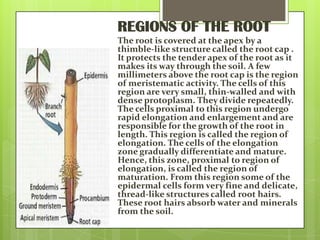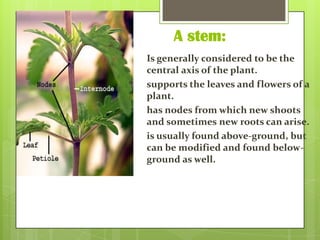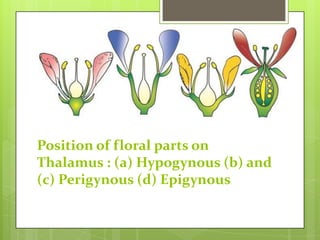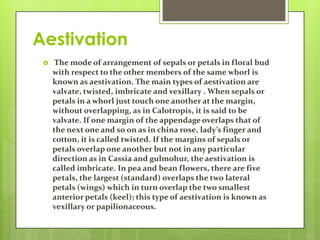Biology
- 2. THE ROOT In majority of the dicotyledonous plants, the direct elongation of the radicle leads to the formation of primary root which grows inside the soil. It bears lateral roots of several orders that are referred to as secondary,
- 3. The primary roots and its branches constitute the tap root system, as seen in the mustard plant . In monocotyledonous plants, the primary root is short lived and is replaced by a large number of roots. These roots originate from the base of the stem and constitute the fibrous root system, as seen in the wheat plant . In some plants, like grass, Monstera and the banyan tree, roots arise from parts of the plant other than the radicle and are called adventitious roots.
- 4. REGIONS OF THE ROOT The root is covered at the apex by a thimble-like structure called the root cap . It protects the tender apex of the root as it makes its way through the soil. A few millimeters above the root cap is the region of meristematic activity. The cells of this region are very small, thin-walled and with dense protoplasm. They divide repeatedly. The cells proximal to this region undergo rapid elongation and enlargement and are responsible for the growth of the root in length. This region is called the region of elongation. The cells of the elongation zone gradually differentiate and mature. Hence, this zone, proximal to region of elongation, is called the region of maturation. From this region some of the epidermal cells form very fine and delicate, thread-like structures called root hairs. These root hairs absorb water and minerals from the soil.
- 5. MODIFICATIONS OF ROOT Roots in some plants change their shape and structure and become modified to perform functions other than absorption and conduction of water and minerals. They are modified for support storage of food and respiration. Tap roots of carrot, turnip and adventitious roots of sweet potato, get swollen and store food. Can you give some more such examples? Have you ever wondered what those hanging structures are that support a banyan tree? These are called prop roots. Similarly, the stems of maize and sugarcane have supporting roots coming out of the lower nodes of the stem. These are called stilt roots. In some plants such as Rhizophora growing in swampy areas, many roots come out of the ground and grow vertically upwards. Such roots, called pneumatophores, help to get oxygen for respiration.
- 6. A stem: Is generally considered to be the central axis of the plant. supports the leaves and flowers of a plant. has nodes from which new shoots and sometimes new roots can arise. is usually found above-ground, but can be modified and found belowground as well.
- 7. Stem Modifications Tubers: Potato Tuber A tuber is an underground stem that stores food. We know a potato is a tuber because it has nodes (eyes) which produce new shoots.
- 8. Bulbs: Bulbs come in 2 basic types: 1. Tunicate bulbs; onions and tulips are examples. Onion Bulb Tunicate bulbs have: A papery outer covering called a tunic. A compressed, modified stem with nodes, called a basal plate. Fleshy scales made of modified leaf tissue. Onion Bulb shown in cross section.
- 9. Scaly Bulbs: The other type of true bulb is a scaly bulb. Scaly bulbs: Lack a papery covering (tunic). Have a basal plate. Have fleshy scales made of leaf tissue. Do not form “onion rings” when cut in cross-section. Lilium in a scaly bulb
- 10. Rhizomes: Rhizomes are: underground stems. horizontally-growing. produce shoots and adventitious roots. The pachymorph rhizome of Ginger
- 11. Stolons: Stolons are: Aboveground stems. Grow horizontally. Produce shoots and adventitious roots. Strawberry and Spider Plant are examples of plants that produce stolons. Wild strawberry stolons.
- 12. THE LEAF: The leaf is a lateral, generally flattened structure borne on the stem. It develops at the node and bears a bud in its axil. The axillary bud later develops into a branch. Leaves originate from shoot apical meristems and are arranged in an acropetal order. They are the most important vegetative organs for photosynthesis.
- 13. VENATION: The arrangement of veins and the Parallel and Reticulate Venations veinlets in the lamina of leaf is termed as venation. When the veinlets form a network, the venation is termed as reticulate. When the veins run parallel to each other within a lamina, the venation is termed as parallel. Leaves of dicotyledonous plants generally possess reticulate venation, while parallel venation is the characteristic of most monocotyledons.
- 14. TYPES OF LEAVES: A leaf is said to be simple, when its lamina is entire or when incised, the incisions do not touch the midrib. When the incisions of the lamina reach up to the midrib breaking it into a number of leaflets, the leaf is called compound. A bud is present in the axil of petiole in both simple and compound leaves, but not in the axil of leaflets of the compound leaf. The compound leaves may be of two types. In a pinnately compound leaf a number of leaflets are present on a common axis, the rachis, which represents the midrib of the leaf as in neem. In palmately compound leaves, the leaflets are attached at a common point, i.e. at the tip of petiole, as in silk cotton
- 15. pinnately compound leaf and palmately compound leaves
- 16. PHYLLOTAXY Phyllotaxy is the pattern of arrangement of leaves on the stem or branch. This is usually of three types – alternate, opposite and whorled. In alternate type of phyllotaxy, a single leaf arises at each node in alternate manner, as in china rose, mustard and sun flower plants. In opposite type, a pair of leaves arise at each node and lie opposite to each other as in Calotropis and guava plants. If more than two leaves arise at a node and form a whorl, it is called whorled, as in Alstonia.
- 17. MODIFICATIONS OF LEAVES Leaves are often modified to perform functions other than photosynthesis. They are converted into tendrils for climbing as in peas or into spines for defence as in cacti. The fleshy leaves of onion and garlic store food. In some plants such as Australian acacia, the leaves are small and short-lived. The petioles in these plants expand, become green and synthesise food. Leaves of certain insectivorous plants such as pitcher plant, venus-fly trap are also modified leaves.
- 18. THE INFLORESCENCE A flower is a modified shoot wherein the shoot apical meristem changes to floral meristem. Internodes do not elongate and the axis gets condensed. The apex produces different kinds of floral appendages laterally at successive nodes instead of leaves. When a shoot tip transforms into a flower, it is always solitary. The arrangement of flowers on the floral axis is termed as inflorescence. Depending on whether the apex gets converted into a flower or continues to grow, two major types of inflorescences are defined – racemose and cymose. In racemose type of inflorescences the main axis continues to grow, the flowers are borne laterally in an acropetal succession.
- 19. In cymose type of inflorescence the main axis terminates in a flower, hence is limited in growth. The flowers are borne in a basipetal order. Cymose Inflorescence Racemose Inflorescence
- 20. THE FLOWER The flower is the reproductive unit in the angiosperms. It is meant for sexual reproduction. A typical flower has four different kinds of whorls arranged successively on the swollen end of the stalk or pedicel, called thalamus or receptacle. These are calyx, corolla, androecium and gynoecium. Calyx and corolla are accessory organs, while androecium and gynoecium are reproductive organs. In some flowers like lily, the calyx and corolla are not distinct and are termed as perianth. When a flower has both androecium and gynoecium, it is bisexual. A flower having either only stamens or only carpels is unisexual.
- 21. In symmetry, the flower may be actinomorphic (radial symmetry) or zygomorphic (bilateral symmetry). When a flower can be divided into two equal radial halves in any radial plane passing through the centre, it is said to be actinomorphic, e.g., mustard, datura, chilly. When it can be divided into two similar halves only in one particular vertical plane, it is zygomorphic, e.g., pea, gulmohur, bean, Cassia. A flower is asymmetric (irregular) if it cannot be divided into two similar halves by any vertical plane passing through the centre, as in canna. A flower may be trimerous, tetramerous or pentamerous when the floral appendages are in multiple of 3, 4 or 5, respectively. Flowers with bracts – reduced leaf found at the base of the pedicel – are called bracteate and those without bracts, ebracteate
- 22. Position of floral parts on Thalamus : (a) Hypogynous (b) and (c) Perigynous (d) Epigynous
- 23. Parts of Flower. Each flower normally has four floral whorls, viz., calyx, corolla, androecium and gynoecium. CALYX The calyx is the outermost whorl of the flower and the members are called sepals. Generally, sepals are green, leaf like and protect the flower in the bud stage. The calyx may be gamosepalous (sepals united) or polysepalous (sepals free). COROLLA Corolla is composed of petals. Petals are usually brightly coloured to attract insects for pollination. Like calyx, corolla may be also united gamopetalous (petals united) or polypetalous (petals free). The shape and color of corolla vary greatly in plants. Corolla may be tubular, bellshaped, funnel-shaped or wheel-shaped.
- 24. Aestivation The mode of arrangement of sepals or petals in floral bud with respect to the other members of the same whorl is known as aestivation. The main types of aestivation are valvate, twisted, imbricate and vexillary . When sepals or petals in a whorl just touch one another at the margin, without overlapping, as in Calotropis, it is said to be valvate. If one margin of the appendage overlaps that of the next one and so on as in china rose, lady’s finger and cotton, it is called twisted. If the margins of sepals or petals overlap one another but not in any particular direction as in Cassia and gulmohur, the aestivation is called imbricate. In pea and bean flowers, there are five petals, the largest (standard) overlaps the two lateral petals (wings) which in turn overlap the two smallest anterior petals (keel); this type of aestivation is known as vexillary or papilionaceous.
- 25. Types of aestivation in corolla : (a) Valvate (b) Twisted (c) Imbricate (d) Vexillary
- 26. Source: NCERT Textbook, Wiki, Google…


























